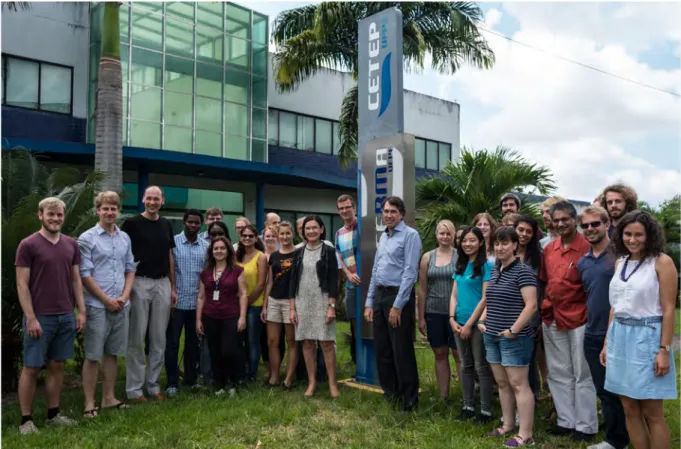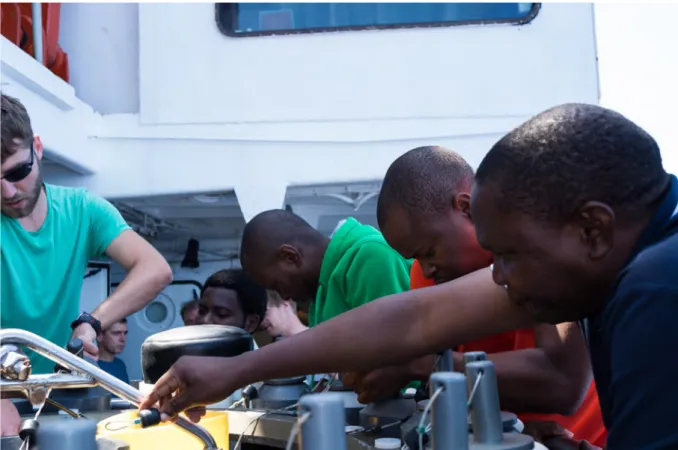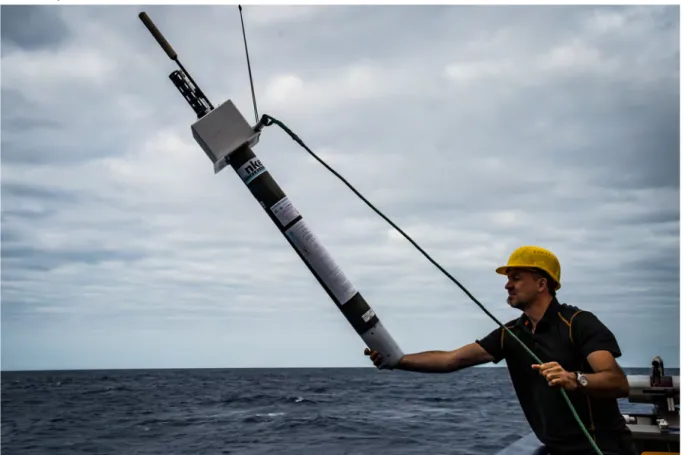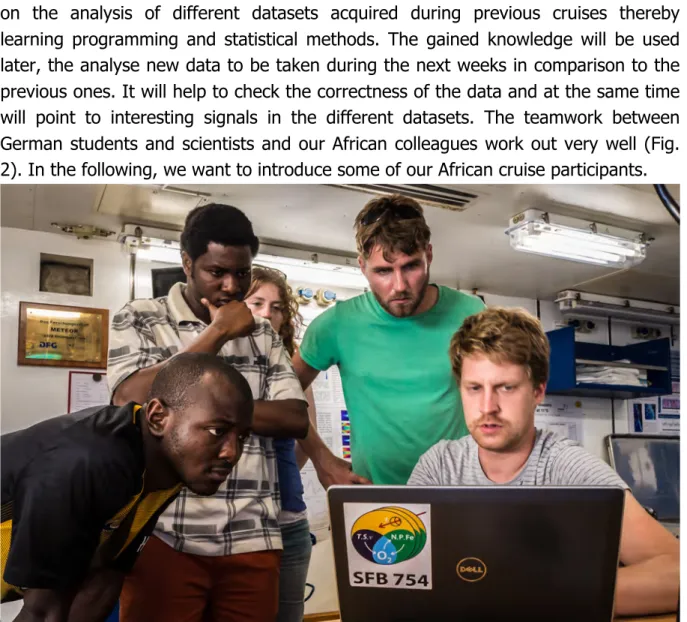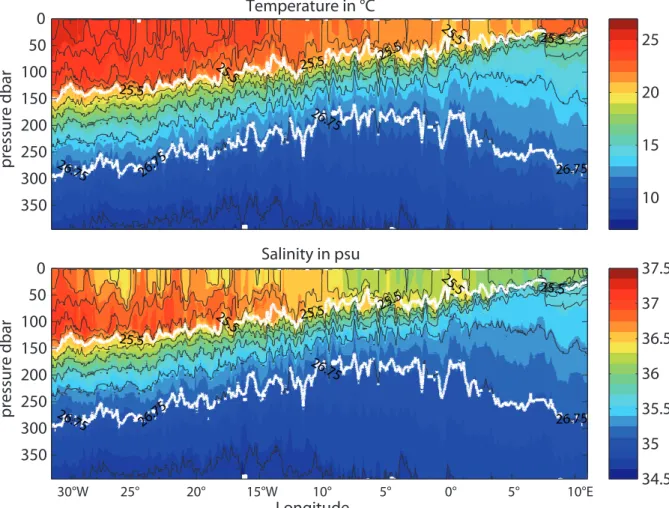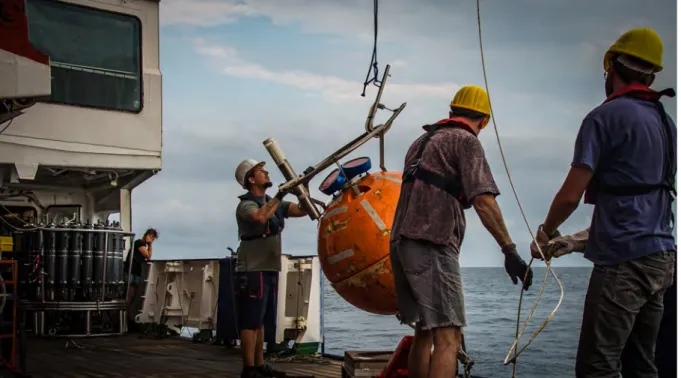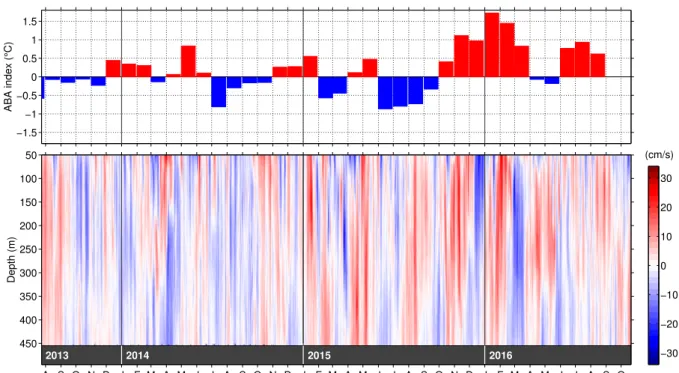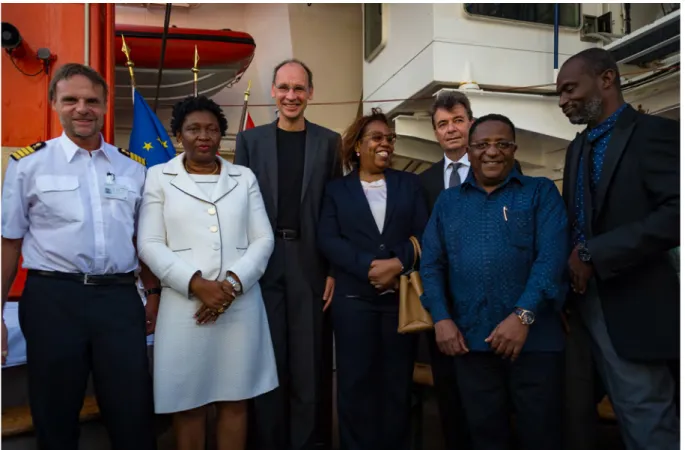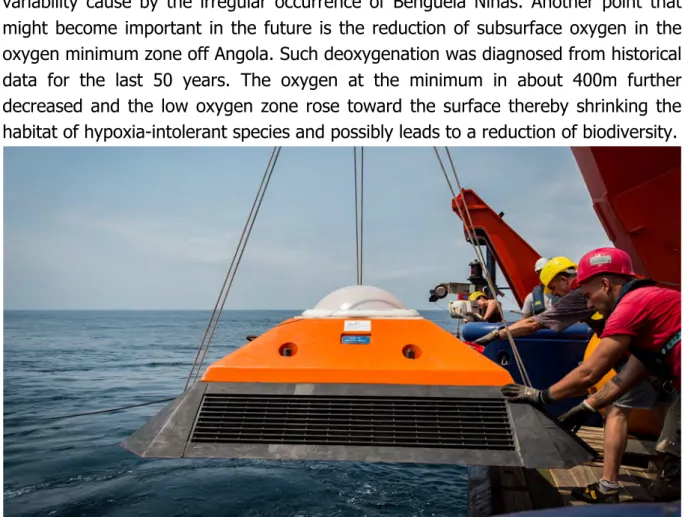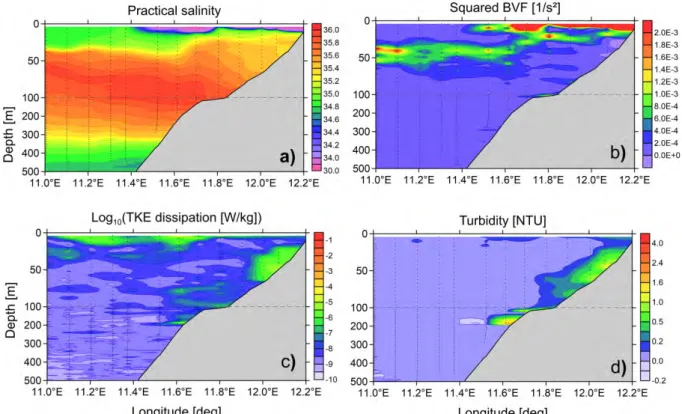1
stWeekly Report M131, Recife-Walvis Bay
Oct. 7-Nov. 12 2016
METEOR cruise M131 from Recife to Walvis Bay began on October 7 2016. The cruise continues measurements carried out during the previous research cruise M130 from Mindelo to Recife, which was led by Marcus Dengler (GEOMAR). The port stops in Recife are often used by our groups to perform together with our scientific partners from the Universidade Federal de Pernambuco in Recife common scientific colloquiums aimed at enhancing the scientific and technical exchange between students, scientists and technicians. This year, on October 5th, we had already the fifth Seminar of the Bilateral Cooperation DOCEAN (Departamento de Oceanografia) – GEOMAR. This time the German Consul General Maria Könning-De Siqueira Regueira participated. She welcomed the scientists and stressed the importance of the visit of the German RV METEOR in Recife. She stated that „science is a fundamental pillar of the cooperation between Brazil and Germany“ (Fig. 1).
Fig. 1: Participants of the 5th Seminar of Bilateral Cooperation DOCEAN – GEOMAR in Recife with the Consul General Maria Könning-De Siqueira Regueira (middle) (Photo: SvN).
On October 6th, a group of school kids from the „Colegio Apoio Recife“ visited us aboard METEOR. They had the possibility to look around the research vessel.
Particularly interesting they found our autonomous robots, which we will deploy later off Angola and Namibia. The research cruise M131 started the next day at 9:30 with the departure of METEOR from the port of Recife. The cruise is part of the EU project PREFACE and the BMBF cooperative project SACUS. The core theme of these projects is the coastal upwelling system off Southwest Africa. Both projects include a close cooperation between German partner institutes, i.e. GEOMAR in Kiel and IOW in Warnemünde, and researchers and institutes from different countries in southern Africa. Therefore, we could welcome colleagues from Angola, Namibia and South Africa aboard METEOR. Together, we want to study ocean and climate variability and their impact on the biological productivity and fisheries, which is of high relevance for those countries.
Besides the focus on the eastern boundary upwelling system, the first part of the cruise is devoted to the study of hydrography and circulation along 11°S between Brazil and Angola. These measurements are part of the BMBF cooperative project RACE, which is particularly aimed to study the variability of the Atlantic meridional overturning circulation. This circulation is characterized by a northward warm water transport, supplying - after crossing the equator - the Gulfstream and the North Atlantic Current and the return flow of cold North Atlantic Deep Water produced in the Labrador Sea and the region north of the sills between Greenland, Iceland and Scotland. During our cruise, we continue measurements started during M130 at the western boundary of Brazil along the 11°S section into the interior Atlantic. We particularly collect data on station with the CTD (conductivity, temperature, depth) probe (Fig. 2) as well as underway with an Underway CTD system. Both instruments as well as the shipboard 38kHz and 75kHz ADCPs (acoustic Doppler current profilers) operates properly.
Fig. 2: Work at sea usually starts with a briefing for the different instrumentation used during the cruise, here it is the preparation of the CTD probe before the station work (Photo: SvN).
After the first days at sea, which are often quite exciting, a routine working atmosphere has been established including hourly measurements with the Underway CTD system and occasionally CTD stations. Overall, all participants immediately felt at home aboard METEOR. Particularly our cruise participants, who are sailing for the first time with METEOR, were deeply impressed by the technical capabilities and also the quality of life aboard this research vessel. Thus, the very good mood aboard is not surprising. It is even enhanced by the excellent working atmosphere and great cooperation with captain Rainer Hammacher and his crew of METEOR.
Greetings from the tropics,
Peter Brandt and the cruise participants of M131
2
ndWeekly Report M131, Recife-Walvis Bay
07.10.-12.11.2016
The transit from Brazil to Angola along 11°S dominates also the second week of METEOR cruise M131 from Recife to Walvis Bay. All cruise participants have been successfully adjusted to the every day work. It consists of hourly measurements with the underway CTD system carried out 24 hour a day in changing watches, occasional CTD stations and the deployment of Argo floats (Fig. 1). Measurements along 11°S are repeatedly performed during different METEOR cruises in the last years (M98, M120). They are part of the BMBF cooperative project RACE and are aimed to investigate water mass changes in the upper ocean of the tropical South Atlantic.
The underway CTD system includes a freefall profiler measuring temperature and salinity as the ship is moving away from the deployment location. After reaching a depth of about 400m the probe is recovered using the winch installed at the ship’s stern. The probe is re-launched time after time without needing to stop or slow down. The underway CTD system worked very well so far and the measurements show the decline of the upper warm water layer from west to east while approaching the upwelling areas off Southwest Africa. This is connected to a sensible reduction in air temperature.
Abb. 1: Auslegen eines Argo Tiefendrifters (Foto: SvN).
Due to the transit, we have the time to present and discuss the scientific work of our cruise participants during daily seminars. It also allows investigating science topics that are not central to own research. We have established different groups focussing on the analysis of different datasets acquired during previous cruises thereby learning programming and statistical methods. The gained knowledge will be used later, the analyse new data to be taken during the next weeks in comparison to the previous ones. It will help to check the correctness of the data and at the same time will point to interesting signals in the different datasets. The teamwork between German students and scientists and our African colleagues work out very well (Fig.
2). In the following, we want to introduce some of our African cruise participants.
Abb. 2: Common analysis of the acquired data. From left: Blessing Kamwi, Rodrigue Anicet Imbol Koungue, Megan Metcalfe, Robert Kopte, Soeren Thomsen (Photo: SvN).
Learning together, to understand the ocean better
The tropic Atlantic Ocean I only know from data, which were collected by oceanographers during previous cruises and which I used for my master degree. My subject now is the study of the circulation of the southeast Atlantic Ocean with the focus on Benguela Nino and Nina.
This is my first time at sea. Never before I have been on a research vessel and I am really grateful for being aboard „Meteor“. During this cruise I can learn, how to deal with the different scientific devices (ADCP, glider, CTD, floats etc.), which measure relevant parameters like temperature, salinity, Chlorophyll, depth, velocity.
Physical processes relevant for the oceanic variability in the southwest African upwelling region and their impacts for example on fisheries is nearly unknown in my home country Cameroon, though fishery is the main income source, but the view of oceanographers is missing.
Collaboration and life on board „Meteor“ are really great. I work together with four German and one Namibian colleague in a watch. Furthermore there are working groups, where we learn to process data. I think, it is important to learn from each other without boundaries in our heads, because the ocean has no boundaries.
At home in Cameroon there was no possibility to study oceanography. Therefore I studied physics and geophysics. Then I went to Benin to study oceanography. Now I am working on my PhD thesis at the University of Cape Town, South Africa under the supervision of Assoc. Prof Mathieu ROUAULT within the EU project PREFACE and hope, that I am able to go back to Cameroon as an oceanographer next year.
Rodrigue Anicet IMBOL KOUNGUE, 27 years old
Besides the preparation of the reception in Luanda, which we do in close cooperation with our partner institute INIP (Instituto Nacional de Investigação Pesqueira Republica de Angola), we have also the possibility to test different instrumentation to be used during the next week in the coastal upwelling region off Southwest Africa.
Among them are instruments to be deployed in moorings and bottom shields, gliders and the ScanFish. Unfortunately, there are quite strong winds and currents against us, which reduces our transit speed somewhat compared to M120 almost exactly one year ago. Anyway, we are looking forward to the upcoming work off Angola and looking forward to arrive in time in Luanda.
Greetings from the tropics,
Peter Brandt and the cruise participants of M131
3
rdWeekly Report M131, Recife-Walvis Bay
07.10.-12.11.2016
After nearly two weeks of crossing the Atlantic with continuous underway measurements (Fig. 1), we arrived at our research area off Angola. In 2013, GEOMAR established together with INIP (Instituto Nacional de Investigação Pesqueira Republica de Angola) an observational program consisting of a current meter mooring array as well as regular shipboard and glider measurements at 11°S.
The measurements are aimed to identify the strength of the Angola current as well as the processes relevant for the functioning of tropical upwelling systems characterized by weak wind forcing, but nevertheless high biological productivity and fish.
Fig. 1: Temperature and salinity along ~11°S from Brazil to Angola as measured with the Underway CTD. White and black lines mark contours of potential density (figure by Sören Thomsen).
In comparison to other socio-economic relevant regions of the World Ocean, the observing system off Angola is only weakly developed. However, ocean observations are often the first step toward a better understanding of the system. They can be used to improve our capabilities to simulate and predict atmosphere and ocean
pressure dbar
Temperature in °C
25.5
25.5 25.5 25.5
25.5 25.5
26.75
26.75
26.75
26.75
0 50 100 150 200 250 300
350 10
15 20 25
Longitude
pressure dbar
Salinity in psu
25.5
25.5 25.5 25.5
25.5 25.5
26.75
26.75
26.75
26.75
30°W 25° 20° 15°W 10° 5° 0° 5° 10°E
0 50 100 150 200 250 300 350
34.5 35 35.5 36 36.5 37 37.5
parameters, for example rainfall, biological productivity or fish stocks that are particularly relevant for Angola. These predictions strongly depend on our knowledge of the evolution of the sea surface temperature off Angola. The sea surface temperature here is forced locally by heat fluxes and wind, but also remotely by the propagation of warm water anomalies along the equator and further southward along the coast off Southwest Africa. The latter events are often called Benguela Niños in case of warm events and Benguela Niñas in case of cold events.
Because of the slower than normal cruise from Brazil to Angola and the date of the reception in Luanda that we had to fix quite early, there was only one day available for our dense observational program at 11°S. During that day, unfortunately we were able to recover only one mooring out of three (Fig. 2, 3). The three autonomous gliders, we had on board, were successfully deployed and sent on mission to measure standard parameters like temperature, salinity, oxygen and chlorophyll together with special microstructure sensors attached to two of the gliders for the measurement of vertical mixing and a nutrient sensor attached to the third glider (see http://gliderweb.geomar.de/html/swarm08.html). During the night the work was continued with the first operation of the ScanFish. This system is used by the working group of IOW. By alternating up- and downward movements it is able to continuously observe the upper ocean while being towed behind the ship at a speed of 6 kn. These observations ended our working program at 11°S and METEOR sailed to our northern most working area that is located close to the Congo river outflow at 6°S.
Fig. 2: Recovery of the top element including the acoustic Doppler current profiler of the mooring within the Angola Current at 11°S (photo: SvN).
Fig. 3: Sea surface temperature anomaly in the Angola-Benguela area (between 10°S and 20°S, and east of 8°E (a) and anomalies of along-shore flow from the first and second mooring period (b).
Strongest southward flow was observed in December 2015, slightly leading warmest temperatures further to the south (figure by Robert Kopte).
Three colleagues from our partner in Angola, the Fisheries Institute, with whom we have been collaborating with since 2013 are on board METEOR during this cruise.
Here we want to report about their motivation for marine sciences as well as about their experience on board METEOR.
For Enoque Vasco, 50 years old, it is already the second cruise with METEOR: „In 2013 I was aboard METEOR the first time and the work and exchange with our German colleagues was so impressive that I decided to continue my work and write my PhD thesis. Therefore I am really grateful that I have the opportunity to join a METEOR cruise again and have the chance to learn more about the work with all the scientific instruments, which we don’t have in Angola. I studied marine biology and worked some years for INIP in Lobito, where we have a monitoring station, which measures temperature, salinity, oxygen and nutrients of the seawater. A data time series from this station (1968 to 2007) I used for my master thesis. Since 2014 I study oceanography in Portugal at the University of Aveiro and at the moment I am writing my PhD thesis with a focus on hydrography and ocean dynamics in the Economic Exclusive Zone of Angola. My family is based in Lobito and of course I would like to work as an oceanographer in my home country.“
Eridson Saquenha, 32 years old, works for CIP-Namibe, INIP in South Angola and this is his first time aboard METEOR:
2013 2014 2015 2016
Depth (m)
A S O N D J F M A M J J A S O N D J F M A M J J A S O N D J F M A M J J A S O 50
100 150 200 250 300 350 400 450
(cm/s)
−30
−20
−10 0 10 20 30
−1.5
−1
−0.5 0 0.5 1 1.5
ABA index (°C)
„The teamwork is really great and the dialogue with the people on board is more than immense. Our German colleagues have an extremely wider comprehension of the ocean than we have in Angola. Some of the instruments like e.g. the gliders are absolutely new for me and it is very interesting to work with them and to see how to process the data. I study environmental engineering and my main research is focused on the question why our fish stocks are declining since the year 2010.
During this cruise I learn more about the physical processes in the ocean, which might be responsible for this situation. Furthermore it is wonderful to make new friends aboard METEOR and to learn more about the work of the oceanographers in Germany.“
Paulo Coelho, 43 years old, work for INIP in Luanda and visited the GEOMAR also:
„The international cooperation within the EU-project PREFACE is very important and this cruise fills it with life. In Luanda we don’t have the same equipment as our German colleagues, but I hope instantly that people in Angola will better understand, that we have to develop a better understanding of the physical processes in the ocean.“
At this point, we would like to thank the crew for the great effort round the clock, which is crucial for the success for our measurement program.
Greetings from the tropics,
Peter Brandt and the cruise participants of M131
4
thWeekly Report M131, Recife-Walvis Bay
07.10.-12.11.2016
At the end of the fourth week of METEOR cruise M131, we have finished or research program in our northernmost research area between 11°S and 6°S composed of high-resolution measurements at CTD and microstructure stations, mooring work, glider deployments and recoveries as well as continuous measurements with both underway CTD systems on board. In the middle of the work program, a reception in the port of Luanda was planned since a while. The organisation of the reception was only possible because of the great help of the INIP (Instituto Nacional de Investigação Pesqueira Republica de Angola) and the German Embassy in Luanda.
The visit of METEOR was very well received in Angola. We could welcome aboard METEOR two ministers, the Minister for Fisheries Dra. Victoria Barros Neto and the Minister for Science and Technology Maria Cándida Teixeira, and the state secretary for aquaculture Dr. Carlos Martinó Cordeiro (Fig. 1). Correspondingly large was the interest by the media with several interviews given to journalists from press and television.
Fig. 1: During the reception aboard METEOR in the port of Luanda on October 25. From left: captain Rainer Hammacher, Dra. Victoria Barros Neto – Minister for Fisheries, chief scientist Peter Brandt, Maria Cándida Teixeira – Minister for Science and Technology, Rainer Müller – German Ambassador in Angola, Dr. Carlos Martinó Cordeiro – State Secretary for Aquaculture, Paulo Coelho (photo: SvN).
In her speech, the fishery minister Dra. Victoria Barros Neto pointed toward the importance of climate change, which represents a grand challenge for the socio- economic development of Angola. The marine ecosystem has been threatened by the consequences of the phenomenon El Niño and the global temperature rise. The minister was pleased about the good collaboration with German marine research institutes and particularly thanked the German government for the support to investigate the dynamics of the marine ecosystem of Angola. After the welcome speeches, which were given besides the fishery minister by captain Rainer Hammacher and the German Ambassador, I had the possibility together with Paulo Coelho from our crew to present our research topics and the work at sea. We have discussed the recent warming of about 1°C during the period from 1950 to 2010 in the waters off Angola during the winter period, but similarly the large interannual variability cause by the irregular occurrence of Benguela Niñas. Another point that might become important in the future is the reduction of subsurface oxygen in the oxygen minimum zone off Angola. Such deoxygenation was diagnosed from historical data for the last 50 years. The oxygen at the minimum in about 400m further decreased and the low oxygen zone rose toward the surface thereby shrinking the habitat of hypoxia-intolerant species and possibly leads to a reduction of biodiversity.
Fig. 2: Deployments of a bottom shield with an acoustic current meter (75kHz Longranger ADCP).
The form of the shield is aimed to prevent damage from fishing activities. This time, we added a 1km bottom line that can help during the recovery in case of a damage of the release inside the shield (photo: SvN).
Directly after the reception in Luanda, we continued our mooring work at 11°S. Two moorings with Longranger ADCPs (one installed in a buoyancy sphere as shown in the last weekly report and one in the bottom shield, Fig. 2) were deployed to observe
the variability of the Angola current. The observed velocities will be additionally used to estimate the strength of the internal wave field. Internal waves that are generated by the tidal currents are associated with energetic velocity fluctuations of about 20- min period. They travel below the surface toward the coast. When reaching shallow waters, they might break thereby inducing mixing and upward transport of nutrients required for the large biological productivity of the marine ecosystem.
Fig. 3: Salinity (a), vertical stratification (b), turbulence (c) and turbidity (d) as measured with the microstructure probe in the area of the Congo outflow at about 6°S (figure by Volker Mohrholz).
During the recent week we performed observations of turbulent mixing along cross- shore transects off the Congo river mouth (Fig. 3) and at 11°S. For these measurements the Microstructure profiler was deployed after each CTD station. The first preliminary analysis of gathered data depict a strong stratification off the Congo river mouth, which is caused by both the intense heating of the surface mixed layer and the fresh water discharge of the Congo river. Near the coast the strong vertical density stratification suppresses the usually high vertical mixing in the surface layer, which is observed along the offshore stations. Hot spots of intense turbulent mixing were found in the near bottom layers at the shelf edge as well as close to the coast.
At the shelf edge, the enhanced turbulent mixing is mainly caused by breaking internal waves. The high mixing rates in the bottom layer near the coast cannot be attributed to particular physical processes yet. It will be a focus of the subsequent data analysis to uncover the contributing processes. In both areas the high turbulence in the bottom layer caused resuspension of sediment particles, seen in strongly enhanced turbidity. The present currents can transport the remobilized
sediment particles down the continental slope. This may contribute to the longterm storage of carbon in the deep ocean.
Now we already approach our research area off Namibia. There has been a longstanding cooperation between IOW and MFMR, NatMIRC (Ministry of Fisheries and Marine Resources, National Marine Information and Research Center). Blessing Kamwi from NatMIRC is on board with us and reports about his experiences.
For Blessing Kamwi, 28 years old, this is the first cruise on METEOR: „In 2014 I had the chance to be on a cruise with the research vessel „Sonne“ in the Indian Ocean.
Life and work at sea are great and you learn a lot. This cruise with „Meteor“ is different, because we have other instruments like the Underway CTD or the Gliders on board. These kind of scientific devices we do not have at our Institute in Namibia – and yes, for sure, it is really great to do all this research work in my „home ocean“ and to learn more about the physical processes in the upwelling areas at the coast of Angola and Namibia.
When I was young I lived with my family far away from the ocean, but one day we visited my uncle in Walvis Bay and it was him, who took me to the sea and went with us to an aquarium. There it all started . . .
So it was really nice to see how happy the kids were, when they visited Meteor in the port of Angola shortly before the official reception began. Maybe one day, some of them will become oceanographers too – you never know.
I studied at the University of Namibia, later I went to the University of Cape Town to study physical oceanography. At the moment I work for the Ministry of Fisheries &
Marine Resources based in Swakopmund, in the environmental section, subsection physical and chemical oceanography. There are not so many oceanographers in my home country and I am glad that I am one of them, because I want to contribute to the knowledge and understanding of the ocean. On this cruise with „Meteor“ my interest is focused on ADCP data processing and I really enjoy the teamwork with my German colleagues. I want to learn more about modelling and of course I would love to go to Germany one day to get some more training at one of the German institutes.”
On Saturday we had our barbecue, which we would like to have in the warm waters of Angola before we approach the windy and cool coastal region off Namibia. The prepared meals were delicious, similarly as they were during the first part of the cruise and particularly also for our vegetarians on board: many thanks to the team in the ship’s kitchen.
Greetings from the tropics,
Peter Brandt and the cruise participants of M131
5
thWeekly Report M131, Recife-Walvis Bay
07.10.-12.11.2016
During the fifth week of METEOR cruise M131, we sailed from the tropical ocean off Angola toward the markedly cooler and rougher areas off Namibia. On the way southward, we cut through the so-called Angola-Benguela frontal zone (ABFZ) located at about 17°S just at the border between the exclusive economic zones of Angola and Namibia. Near the front, the water temperature drops within a few miles from about 22°C north to 16°C south of the front. The correct simulation of the ABFZ is still a challenge for coupled climate models. A misrepresentation of the location of the front results in large errors in the simulated sea surface temperature with consequences for the simulated climate of the tropical Atlantic as well as globally. An important aspect defining the location of the front is the forcing by along-shore winds. However, oceanic processes, like the advection of water mass anomalies, the rising and deepening of the oceanic thermocline associated with propagation of coastally trapped waves with periods of months to years, or the vertical mixing and associated downward heat transport, might play an important role as well.
After finishing the CTD and microstructure program along 15°S, still north of the front, we started high-resolution measurements across the ABFZ with the Underway CTD. The RapidCast system delivered by Teledyne Oceanscience is capable to acquire temperature and salinity profiles at full ship speed down to about 120m depth with a temporal resolution of 4 to 5 minutes resulting in a spatial resolution of about 1.5 km. The gained dataset nicely show the dramatic temperature decrease from north to south as well as the strong, episodic deepenings of the oceanic mixed layer south of the front (Fig. 1).
Fig. 1: Temperature in the upper ocean as measured with the Rapid Cast system (color scale). The thick grey line marks the mixed layer depth. Vertical mixing profiles (grey shaded) are superimposed at the measurement position with the scale given in the upper x-axis (Figure: Sören Thomsen).
pressure in dbar
Temperature
18°S 17.5°S 17°S 16.5°S 16°S 15.5°S
0 20 40 60
80
15 16 17 18 19 20 21 22
-6 -2 log10(TKE dissipation in W/kg) 23
[°C]
The following program of M131 includes hydrographic cross-shelf sections off Namibia at 18°S, 20°S and 23°S. Besides CTD and microstructure measurements as well as sediment grab and dredge sampling, we serviced several moorings on these sections. Up to now, we were able to successfully recover the IOW bottom shields at the shelf at 18°S and 20°S (Fig. 2). The mooring work of our cruise will be accomplished shortly before reaching Walvis Bay, the final destination of METEOR cruise M131. The moorings on the shelf off Namibia are, amongst others, equipped with acoustic Doppler current profilers. These instruments measure time series of the full-depth velocity, thereby allowing to follow signals in the along-shore flow that might propagate along the southwest African coast from the equator as far south as Walvis Bay. Associated changes in water mass properties, like temperature, nutrients and/or oxygen directly affect the biological productivity in the eastern boundary upwelling region.
Fig. 2: Successful recovery of the IOW bottom shield equipped with an ADCP on the shelf off Namibia at 18°S (photo: SvN).
Besides our ongoing measurement program, the already acquired data are directly analysed by the students and scientists aboard. Particularly, the working groups established at the beginning of the cruise made good progress, which was reported regularly during our seminar series. The cooperation between German scientists and students and their African colleagues was very intense throughout the cruise (Fig. 3)
thereby producing new or even unexpected scientific results that might be the basis for future Bachelor, Master or PhD thesis in their home institutes or will be part of the regular scientific project work. For sure, the common work aboard will help to increase the cooperation in already planned common projects aimed at studying the eastern boundary upwelling system of Southwest Africa.
Fig. 3: Good cooperation within the working groups during common data analysis. From left: Thea Hamm, Enoque Vasco, Paulo Coelho, Eike Koehn (photos: SvN).
Here some statements regarding our cooperation on board:
„I am impressed by the long-term datasets of our colleagues from Angola and Namibia. They represent important measurements over a long period in time that will help to understand long-term changes in the coastal upwelling regions off Southwest Africa. Up to now, I hadn’t the possibility to work with the data and it was particularly interesting for me the get a first impression of the data available in our partner institutes“, says Josefine Herrford, 27 years old. As PhD student at GEOMAR she studies water masses and large-scale circulation in the South Atlantic.
Long-term cooperation and an emancipated exchange at eye level are crucial when working together, opines Sören Thomsen, 30 years old and PostDoc at GEOMAR. The topic of his research is “small-scale temperature fronts in upwelling areas”. The cruise with METEOR brought new insight in different aspects of the study area.
„However, 5 weeks on the ship or 3 years of a project are not enough to understand the relevant processes in this region of the World Ocean. In Angola and Namibia, scientists go at sea every day partly since more than 30 years to measure different parameters of their ocean. Such long-term observations are crucial to address climate variability and change; this is another reason for the importance of a long- term engagement and cooperation.“
For Hannah Wiese, 25 years old, Master student in „Climate Physics“, it is the first cruise with METEOR: „I had to learn the sequence of operations and the work on board the same way as my colleagues from Angola, Namibia and South Africa. I wouldn’t forego the group work or the common watches for example at the CTD stations and the Underway CTD. Together, we have analysed data accompanied by interesting discussions. I think, it would be great, if this cooperation could be
intensified, for example during summer schools or with the exchange of scientists and students. I would like to work for few months at one of the partner institutes in Africa and, of course, I would be happy, if students from the African countries we cooperate with, would visit us at our institute in Kiel. “
Besides our full working program until the last day of the cruise, packing of instrumentation and equipment has already started. METEOR will arrive in Walvis Bay on November 12. There, we will meet the new chief scientist and part of her crew to discuss the usage of different instrumentation that was used during our cruise and will be used during the following one. So, we look back to a very intense and successful research cruise with very good, harmonic and joyful mood. I would like to personally thank the whole scientific crew for their work during the cruise and, of course, we would like to thank captain Rainer Hammacher and his crew for the excellent working environment, the friendly atmosphere, and last but not least the great hospitality. At the end, just a few words about our guest aboard: Stephanie von Neuhoff. She works as freelance journalist and author. During our cruise, she intensively looked at the cooperation between Germany and Africa at different levels reaching from the scientific, political and institutional to the personal level within the cooperation between students and scientist during the daily work aboard METEOR.
The results of her work include many fascinating photos, text contributions for our public relations and, of course, ideas and thoughts emerging from many discussion about our work and our motivation. The material produced aboard will be used in different projects of her that will be continued commonly beyond the cruise. As an example, the International Maritime Museum Hamburg will show a selection of photos taken during the cruise in a large-sized projection in the frame of the „30 Years Meteor-Celebration“ and present an exhibition of the history of METEOR.
Greetings from the tropics,
Peter Brandt and the cruise participants of M131
